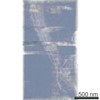+ データを開く
データを開く
- 基本情報
基本情報
| 登録情報 | データベース: EMDB / ID: EMD-20061 | |||||||||
|---|---|---|---|---|---|---|---|---|---|---|
| タイトル | Three-dimensional architecture of epithelial primary cilia | |||||||||
 マップデータ マップデータ | UCSF Chimera: contour level 95 with "hide dust" (1.36e 04) | |||||||||
 試料 試料 |
| |||||||||
| 生物種 |  | |||||||||
| 手法 | 電子線トモグラフィー法 / ネガティブ染色法 | |||||||||
 データ登録者 データ登録者 | Sun S / Fisher RL / Bowser SS / Pentecost BT / Sui H | |||||||||
 引用 引用 |  ジャーナル: Proc Natl Acad Sci U S A / 年: 2019 ジャーナル: Proc Natl Acad Sci U S A / 年: 2019タイトル: Three-dimensional architecture of epithelial primary cilia. 著者: Shufeng Sun / Rebecca L Fisher / Samuel S Bowser / Brian T Pentecost / Haixin Sui /  要旨: We report a complete 3D structural model of typical epithelial primary cilia based on structural maps of full-length primary cilia obtained by serial section electron tomography. Our data demonstrate ...We report a complete 3D structural model of typical epithelial primary cilia based on structural maps of full-length primary cilia obtained by serial section electron tomography. Our data demonstrate the architecture of primary cilia differs extensively from the commonly acknowledged 9+0 paradigm. The axoneme structure is relatively stable but gradually evolves from base to tip with a decreasing number of microtubule complexes (MtCs) and a reducing diameter. The axonemal MtCs are cross-linked by previously unrecognized fibrous protein networks. Such an architecture explains why primary cilia can elastically withstand liquid flow for mechanosensing. The nine axonemal MtCs in a cilium are found to differ significantly in length indicating intraflagellar transport processes in primary cilia may be more complicated than that reported for motile cilia. The 3D maps of microtubule doublet-singlet transitions generally display longitudinal gaps at the inner junction between the A- and B-tubules, which indicates the inner junction protein is a major player in doublet-singlet transitions. In addition, vesicles releasing from kidney primary cilia were observed in the structural maps, supporting that ciliary vesicles budding may serve as ectosomes for cell-cell communication. | |||||||||
| 履歴 |
|
- 構造の表示
構造の表示
| ムービー |
 ムービービューア ムービービューア |
|---|---|
| 添付画像 |
- ダウンロードとリンク
ダウンロードとリンク
-EMDBアーカイブ
| マップデータ |  emd_20061.map.gz emd_20061.map.gz | 994.5 MB |  EMDBマップデータ形式 EMDBマップデータ形式 | |
|---|---|---|---|---|
| ヘッダ (付随情報) |  emd-20061-v30.xml emd-20061-v30.xml emd-20061.xml emd-20061.xml | 10.2 KB 10.2 KB | 表示 表示 |  EMDBヘッダ EMDBヘッダ |
| 画像 |  emd_20061.png emd_20061.png | 67.4 KB | ||
| アーカイブディレクトリ |  http://ftp.pdbj.org/pub/emdb/structures/EMD-20061 http://ftp.pdbj.org/pub/emdb/structures/EMD-20061 ftp://ftp.pdbj.org/pub/emdb/structures/EMD-20061 ftp://ftp.pdbj.org/pub/emdb/structures/EMD-20061 | HTTPS FTP |
-検証レポート
| 文書・要旨 |  emd_20061_validation.pdf.gz emd_20061_validation.pdf.gz | 76.7 KB | 表示 |  EMDB検証レポート EMDB検証レポート |
|---|---|---|---|---|
| 文書・詳細版 |  emd_20061_full_validation.pdf.gz emd_20061_full_validation.pdf.gz | 75.8 KB | 表示 | |
| XML形式データ |  emd_20061_validation.xml.gz emd_20061_validation.xml.gz | 500 B | 表示 | |
| アーカイブディレクトリ |  https://ftp.pdbj.org/pub/emdb/validation_reports/EMD-20061 https://ftp.pdbj.org/pub/emdb/validation_reports/EMD-20061 ftp://ftp.pdbj.org/pub/emdb/validation_reports/EMD-20061 ftp://ftp.pdbj.org/pub/emdb/validation_reports/EMD-20061 | HTTPS FTP |
-関連構造データ
- リンク
リンク
| EMDBのページ |  EMDB (EBI/PDBe) / EMDB (EBI/PDBe) /  EMDataResource EMDataResource |
|---|
- マップ
マップ
| ファイル |  ダウンロード / ファイル: emd_20061.map.gz / 形式: CCP4 / 大きさ: 1.4 GB / タイプ: IMAGE STORED AS SIGNED BYTE ダウンロード / ファイル: emd_20061.map.gz / 形式: CCP4 / 大きさ: 1.4 GB / タイプ: IMAGE STORED AS SIGNED BYTE | ||||||||||||||||||||||||||||||||||||||||||||||||||||||||||||||||||||
|---|---|---|---|---|---|---|---|---|---|---|---|---|---|---|---|---|---|---|---|---|---|---|---|---|---|---|---|---|---|---|---|---|---|---|---|---|---|---|---|---|---|---|---|---|---|---|---|---|---|---|---|---|---|---|---|---|---|---|---|---|---|---|---|---|---|---|---|---|---|
| 注釈 | UCSF Chimera: contour level 95 with "hide dust" (1.36e 04) | ||||||||||||||||||||||||||||||||||||||||||||||||||||||||||||||||||||
| ボクセルのサイズ | X=Y=Z: 11.78 Å | ||||||||||||||||||||||||||||||||||||||||||||||||||||||||||||||||||||
| 密度 |
| ||||||||||||||||||||||||||||||||||||||||||||||||||||||||||||||||||||
| 対称性 | 空間群: 1 | ||||||||||||||||||||||||||||||||||||||||||||||||||||||||||||||||||||
| 詳細 | EMDB XML:
CCP4マップ ヘッダ情報:
| ||||||||||||||||||||||||||||||||||||||||||||||||||||||||||||||||||||
-添付データ
- 試料の構成要素
試料の構成要素
-全体 : primary cilium #A
| 全体 | 名称: primary cilium #A |
|---|---|
| 要素 |
|
-超分子 #1: primary cilium #A
| 超分子 | 名称: primary cilium #A / タイプ: organelle_or_cellular_component / ID: 1 / 親要素: 0 詳細: IMCD3 primary cilium #A is related to Fig. S3a, Fig.S4a, and movie 6. |
|---|---|
| 由来(天然) | 生物種:  |
-実験情報
-構造解析
| 手法 | ネガティブ染色法 |
|---|---|
 解析 解析 | 電子線トモグラフィー法 |
| 試料の集合状態 | cell |
- 試料調製
試料調製
| 緩衝液 | pH: 7.4 / 詳細: PBS |
|---|---|
| 染色 | タイプ: POSITIVE / 材質: uranyl acetate, lead citrate 詳細: 2% uranyl acetate and Reynolds lead citrate solution |
| 糖包埋 | 材質: epoxy resin 詳細: The samples were infiltrated with a graded series of resins (SPI-PON 812, SPI-CHEM, USA) in acetone over 24 hours. After infiltration with pure resin (3 x within 24 hours), the specimens in ...詳細: The samples were infiltrated with a graded series of resins (SPI-PON 812, SPI-CHEM, USA) in acetone over 24 hours. After infiltration with pure resin (3 x within 24 hours), the specimens in resin were polymerized at 60 degrees C for 2 days. |
| グリッド | 詳細: unspecified |
| 切片作成 | ウルトラミクロトーム - 装置: UC6 microtome / ウルトラミクロトーム - 温度: 298 K / ウルトラミクロトーム - 最終 厚さ: 120 nm |
| 位置合わせマーカー | Manufacturer: Sigma-Aldrich / 直径: 10 nm |
- 電子顕微鏡法
電子顕微鏡法
| 顕微鏡 | FEI TECNAI 20 |
|---|---|
| 撮影 | フィルム・検出器のモデル: TVIPS TEMCAM-F416 (4k x 4k) 平均電子線量: 7.0 e/Å2 |
| 電子線 | 加速電圧: 200 kV / 電子線源:  FIELD EMISSION GUN FIELD EMISSION GUN |
| 電子光学系 | 照射モード: FLOOD BEAM / 撮影モード: BRIGHT FIELD |
- 画像解析
画像解析
| 最終 再構成 | アルゴリズム: SIMULTANEOUS ITERATIVE (SIRT) / ソフトウェア - 名称: TOMO3D 詳細: This SSET work used a series of single-axis tilt data sets. 使用した粒子像数: 1323 |
|---|
 ムービー
ムービー コントローラー
コントローラー










